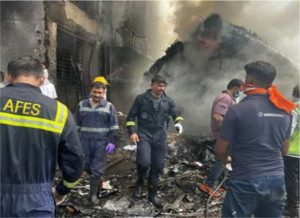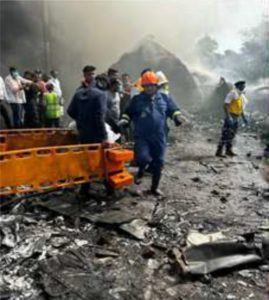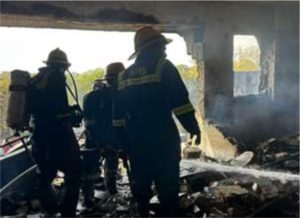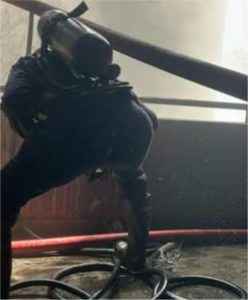Ahmedabad Fire & Emergency Services
Heroic Response to the Air India AI171 Crash on 12 June 2025
A Comprehensive Analysis of India’s Groundbreaking Aviation Emergency Operation A Benchmark in Urban and Airport Disaster Response
 On the afternoon of June 12, 2025, the skies OF Ahmedabad witnessed a Major Tragedy incident that tested the mettle of India’s emergency preparedness apparatus. Air India Flight AI171, scheduled to fly from Ahmedabad to London, became the center of a major aviation disaster shortly after takeoff from Sardar Vallabhbhai Patel International Airport. The ensuing emergency response was nothing short of exemplary spearheaded by the Ahmedabad Fire & Emergency Services (AFES), which mobilized one of the most efficient and rapid urban firefighting and rescue deployments in Indian aviation history.
On the afternoon of June 12, 2025, the skies OF Ahmedabad witnessed a Major Tragedy incident that tested the mettle of India’s emergency preparedness apparatus. Air India Flight AI171, scheduled to fly from Ahmedabad to London, became the center of a major aviation disaster shortly after takeoff from Sardar Vallabhbhai Patel International Airport. The ensuing emergency response was nothing short of exemplary spearheaded by the Ahmedabad Fire & Emergency Services (AFES), which mobilized one of the most efficient and rapid urban firefighting and rescue deployments in Indian aviation history.
In this comprehensive analysis, we explore in depth the operational chronology, strategic decisions, technical deployments, leadership coordination, and post-incident learning that together constitute a powerful case study in aviation emergency response for technically informed stakeholders, safety professionals, and public policy experts alike.
The incident commenced at precisely 13:43 IST, when distress signals were simultaneously received from both the Air Traffic Control (ATC) tower and the Airport Rescue & Firefighting (ARFF) Station. These alerts reported critical engine malfunction and a resultant crash around 500 meters from the boundary of the airport involving the AI171 flight. Within just two minutes—by 13:45 IST—AFES initiated full-scale deployment from its command centers across Ahmedabad.
This rapid response was not a matter of chance but the outcome of a meticulously maintained disaster readiness framework and continuous training modules refined over years of simulation and real-event handling. Fire tenders, emergency rescue vehicles, ambulances, and incident command officers were dispatched in synchronized waves from all 19 fire stations of Ahmedabad. These waves converged at the crash site, coordinated with pinpoint precision, to perform simultaneous firefighting, search and rescue, medical evacuation, and salvage operations.
Most Effective Firefighting and Rescue Operation
 In terms of sheer scale, the numbers paint an astonishing picture of the operational effort. A total of 91 task-specific teams comprising 367 trained personnel were deployed. The composition of these teams demonstrated a layered tactical approach. The Urban Search and Rescue (USAR) division, consisting of 26 teams and 68 dedicated members, was immediately tasked with penetrating the debris and structural remains of the aircraft to extract survivors. Equipped with SCBAs (Self-Contained Breathing Apparatus), hydraulic cutters, thermal imagers, and rope descent gear, they conducted internal and peripheral searches in extremely hostile conditions.
In terms of sheer scale, the numbers paint an astonishing picture of the operational effort. A total of 91 task-specific teams comprising 367 trained personnel were deployed. The composition of these teams demonstrated a layered tactical approach. The Urban Search and Rescue (USAR) division, consisting of 26 teams and 68 dedicated members, was immediately tasked with penetrating the debris and structural remains of the aircraft to extract survivors. Equipped with SCBAs (Self-Contained Breathing Apparatus), hydraulic cutters, thermal imagers, and rope descent gear, they conducted internal and peripheral searches in extremely hostile conditions.
 Simultaneously, the firefighting division constituted of 68 firefighting squads engaged in multi-angle flame suppression using a combination of high-capacity water bowsers, foam-based retardants, and advanced robotics like the “Sheshnaag” firefighting robot team, capable of entering areas deemed unsafe for human entry. A total of 218 personnel operated in this vertical alone, highlighting the human capital investment in containing the inferno and cooling the post-combustion zones.
Simultaneously, the firefighting division constituted of 68 firefighting squads engaged in multi-angle flame suppression using a combination of high-capacity water bowsers, foam-based retardants, and advanced robotics like the “Sheshnaag” firefighting robot team, capable of entering areas deemed unsafe for human entry. A total of 218 personnel operated in this vertical alone, highlighting the human capital investment in containing the inferno and cooling the post-combustion zones.
In another critical layer, the salvage division brought in 12 teams with specialization in aviation incident recovery, who worked to remove structural remnants, fuselage debris, and flammable materials. They were supported by four earthmovers and multiple cranes, ensuring that clearance operations did not compromise the safety of rescue workers or delay medical evacuations.
Equally vital were the 11 ambulance and triage units, outfitted with trauma care kits, oxygen administration tools, and rapid stabilization modules. These teams facilitated the safe transport of injured passengers to Civil Hospital Ahmedabad—an institution already on high alert under the city’s mass casualty incident protocol. Control room operations, vehicle servicing teams, and inventory logistics personnel operated in the background to ensure uninterrupted flow of firefighting agents, medical equipment, and manpower deployment.
Effective Command Structure and High-Tech Coordination
 The command structure of the operation was a defining feature that ensured synchronization among such a vast array of functional units. Led by 27 senior officers, including fire chiefs, sector commanders, and public safety advisors, the incident was managed under an adaptive command hierarchy which pivoted from central to modular control as needed. This minimized information latency, reduced operational conflicts, and allowed for tactical flexibility. Live drone feeds, integrated Geographic Information System (GIS) mapping, and satellite communication tools were employed to provide a 360-degree visual status report to commanders at any given moment. This technological backbone was critical in ensuring that decisions were data-driven, not intuition-based.
The command structure of the operation was a defining feature that ensured synchronization among such a vast array of functional units. Led by 27 senior officers, including fire chiefs, sector commanders, and public safety advisors, the incident was managed under an adaptive command hierarchy which pivoted from central to modular control as needed. This minimized information latency, reduced operational conflicts, and allowed for tactical flexibility. Live drone feeds, integrated Geographic Information System (GIS) mapping, and satellite communication tools were employed to provide a 360-degree visual status report to commanders at any given moment. This technological backbone was critical in ensuring that decisions were data-driven, not intuition-based.
Perhaps the most remarkable dimension of this response was the simultaneity of operations. Traditionally, aviation fire response begins with flame suppression, followed by rescue, then salvage. In contrast, the AFES executed a tri-pronged simultaneous deployment—rescue teams entered wreckage zones even as fire squads doused flames and salvage teams cleared escape paths. This concurrent methodology was high-risk but immensely rewarding: 31 individuals were actually rescued from the impact zone. A cluster of buildings including parked vehicles was engulfed by airplane fuel fire, intensifying the challenge.
Inter-Agency Collaboration and Medical Response
The scale of this operation demanded support beyond city limits. Firefighting reinforcements and resources were provided by nearby corporations, municipalities, ONGC, GIFT City, NDRF, CISF, SDRF, Indian Army, NGOs, and administrative assistance was rendered by the Police Department. Additionally, a coordinated medical response was launched with more than 60 ambulances and expert medical teams mobilized to shift the injured to Civil Hospital, Ahmedabad, one of the city’s largest trauma care centers.
Technological Arsenal and Legacy Learnings
Beyond the human effort and tactical prowess lay a robust technological arsenal. The incident saw the deployment of 109 fire tenders, 60 ambulances, and an extensive inventory of SCBA kits, spare oxygen cylinders, trauma bags, LED floodlights, aerial hydraulic lifts, and even satellite radios to counter potential communication breakdowns. The use of a “fire water relay system” a staged water replenishment network using inline pumps and tankers—ensured that suppression operations were not hindered by fluctuating supply from nearby hydrants. Furthermore, drone-mounted thermal sensors helped identify survivors trapped in isolated sections of the fuselage, where human access was delayed due to persistent heat pockets.
The success of the AFES in managing the crisis led to widespread recognition not only from the media and public but also from the Ministry of Civil Aviation and the National Disaster Management Authority (NDMA), who have since recommended the integration of AFES protocols into national aviation incident response templates.
Important learnings emerged from the aftermath:
- Crowd management requires enforceable legal protocols.
- Communication lapses during the first 30 minutes reinforced the need for satellite backup systems.
- The absence of a Unified Incident Command System (UICS) delayed multi-agency synchronization.
AFES has advocated for the inclusion of UICS and enhanced full-scale simulations involving aviation-specific disaster scenarios in future urban planning.
A Legacy of Courage and Professionalism
While investigations into the exact cause of the crash remain ongoing, the response itself has become a benchmark in India’s evolving disaster response architecture. It is a powerful reminder of the value of resilient infrastructure, trained personnel, inter-agency collaboration, and cutting-edge technology. It also highlights the unsung heroism of municipal fire services—the very first responders in every urban emergency.
In conclusion, the response to the Air India Flight AI171 incident will be remembered not only for the lives saved and damages controlled but also for the unwavering courage, technical brilliance, and professional excellence displayed by the Ahmedabad Fire & Emergency Services. Their actions reaffirm the critical role that municipal emergency services play in securing air transport systems, protecting urban populations, and building public trust in governance. As India expands its global aviation footprint, this incident serves as a clarion call for greater investment in preparedness, infrastructure, and unified action.
The legacy of 12 June 2025 will be one of tragedy met with triumph—of humanity, of science, and of service.























































